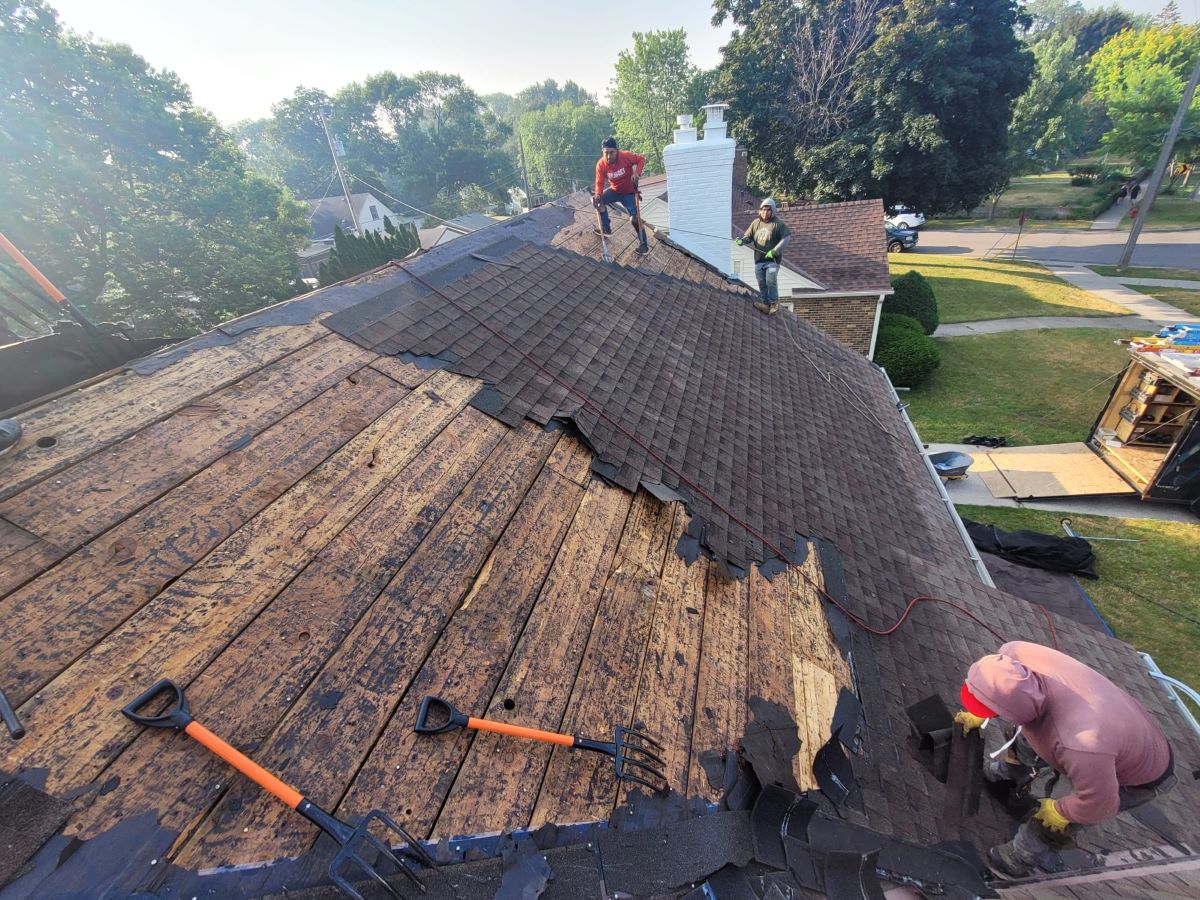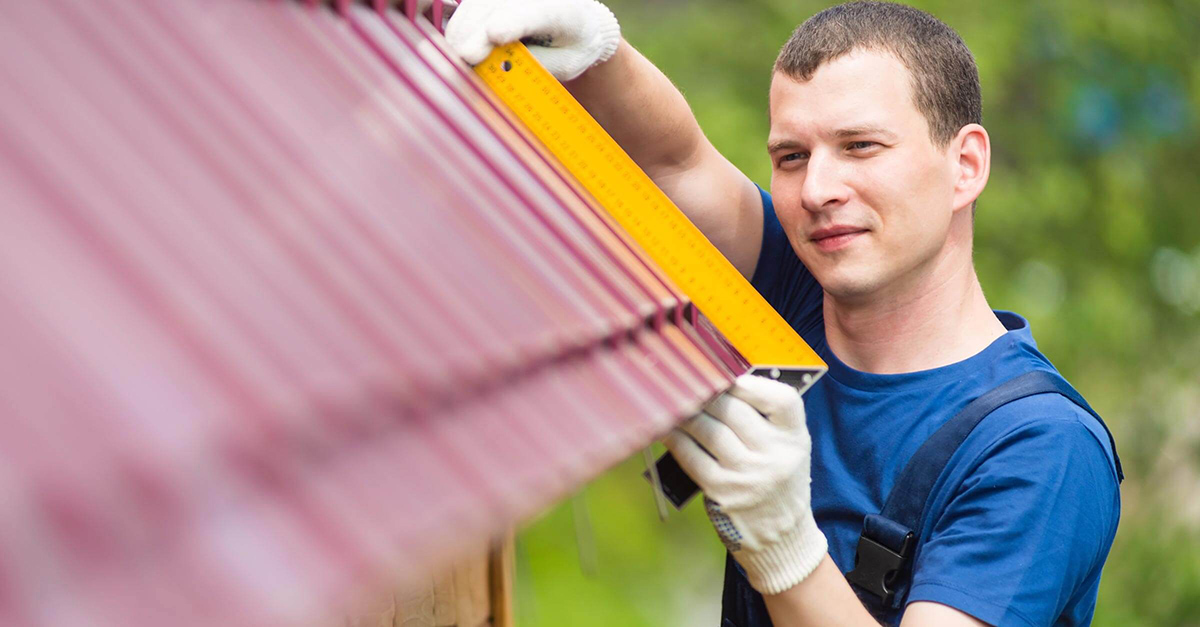

Finance
How To Get A New Roof Through Insurance
Modified: March 1, 2024
Learn how to finance a new roof through insurance, ensuring that you receive the coverage you need without breaking the bank. Get expert tips on navigating the insurance process and saving money on roof replacement.
(Many of the links in this article redirect to a specific reviewed product. Your purchase of these products through affiliate links helps to generate commission for LiveWell, at no extra cost. Learn more)
Table of Contents
Introduction
Having a strong and reliable roof is crucial for the safety and protection of your home. However, unforeseen circumstances such as severe weather events, accidents, or wear and tear can cause damage to your roof. When faced with the need for a new roof, the cost can be overwhelming. Luckily, if you have homeowners insurance, you may be able to get a new roof through your policy.
Understanding the process of getting a new roof through insurance can be complex and intimidating. In this article, we will guide you through the necessary steps to navigate the claims process smoothly and successfully.
Before delving into the intricate details of insurance claims, it is essential to have a comprehensive understanding of your insurance policy. Familiarize yourself with the coverage and deductibles applicable to your roof. Most insurance policies cover damage caused by unforeseen events, such as storms, wind, hail, or falling objects. However, damage caused by normal wear and tear or lack of maintenance may not be covered.
When faced with roof damage, it is important to assess the extent of the problem. Inspect your roof for visible signs, such as missing or damaged shingles, leaks, sagging, or cracks. Additionally, inspect your attic for any signs of water damage, mold, or rotting wood. Taking photographs and documenting the damage will be beneficial later during the claims process.
Once you have assessed the damage, it is time to contact your insurance provider. Notify them of the situation and inquire about the process of filing a claim for a new roof. Many insurance companies have specific requirements and documentation needed for the claims process. They will provide you with the necessary information and guide you through the next steps.
Filing a roof replacement claim requires careful attention to detail. Provide your insurance company with all the required information, including the date and time of the incident, a thorough description of the damage, and any supporting evidence you have documented. Be clear and concise in your communication to ensure a smooth claims process.
Understanding Your Insurance Policy
Before embarking on the process of getting a new roof through insurance, it is imperative to understand the details of your homeowners insurance policy. Familiarize yourself with the coverage, limits, deductibles, and exclusions that pertain specifically to your roof.
Start by reviewing your insurance policy documents thoroughly. Pay close attention to the sections that outline coverage for structural damage, such as the roof. Look for specific language that describes the events or perils covered, such as wind, hail, fire, or vandalism.
It’s important to note that not all insurance policies provide the same level of coverage. Some policies may have exclusions or limitations, such as not covering damage from certain types of storms or only paying for the depreciated value of the roof, rather than full replacement cost. Understanding these nuances will help manage your expectations and navigate the claims process more effectively.
Take note of your policy’s deductible, which is the amount you are responsible for paying out of pocket before the insurance company begins covering the costs. It’s essential to have a clear understanding of your deductible amount, as this will determine your financial obligation in the event of a roof replacement.
Another crucial aspect to consider is the age of your roof. Insurance companies may have different policies regarding roof coverage based on its age. Some insurers may only cover roofs that are under a certain age threshold, while others may prorate the coverage based on the age of the roof.
If you have any questions or uncertainties about your policy, don’t hesitate to contact your insurance agent or representative. They can provide clarification and help ensure you have a full understanding of your coverage.
Remember, insurance policies can be complex documents with legal jargon and specific terms. If you’re unsure about any aspect, it may be helpful to consult with an insurance professional or attorney who can provide guidance and explain the intricacies of your policy.
By taking the time to understand your insurance policy, you can be better prepared when it comes to filing a claim for a new roof. This knowledge will empower you to navigate the claims process and maximize your chances of receiving the coverage you are entitled to.
Assessing Roof Damage
When faced with the need for a new roof, it’s crucial to assess the extent of the damage before filing a claim with your insurance company. Properly documenting the damage will help support your claim and ensure you receive appropriate coverage. Here are some steps to follow when assessing roof damage:
- Inspect the exterior: Start by visually examining your roof from the ground. Look for any obvious signs of damage, such as missing or damaged shingles, curling or buckling, or areas where the roof appears to be sagging. Take note of any visible debris or signs of water pooling on the roof.
- Check for leaks: Inspect your attic for any signs of water intrusion, such as water stains or discoloration on the ceiling, damp insulation, or visible dripping during rain. These are indicators that your roof may have leaks.
- Examine the gutters: Check the gutters and downspouts for any accumulation of shingle granules, which could indicate that your roof’s shingles are deteriorating. Additionally, look for any debris, such as tree branches or leaves, that may have caused damage to the roof.
- Inspect flashing and seals: Inspect the flashing around chimneys, vents, skylights, and other roof penetrations. Look for signs of damage or deterioration, such as cracks or gaps. Check the seals around these areas to ensure they are intact and not causing any moisture penetration.
- Document the damage: Take detailed photographs and videos of the roof damage from multiple angles. This documentation will serve as evidence when filing an insurance claim. Make sure to capture both close-up shots of specific damage and wider shots to show the overall condition of the roof.
- Hire a professional roofer: It’s always a good idea to consult with a professional roofer to assess the damage accurately. They have the expertise to spot subtle signs of damage that an untrained eye may miss. A professional assessment can provide a comprehensive report that will further strengthen your claim.
Remember, safety should be a top priority when inspecting your roof. If you are uncomfortable with heights or unsure about navigating your roof safely, it’s best to leave the assessment to a professional.
By conducting a thorough assessment of your roof damage, you will have a clear understanding of the scope of repairs or replacement needed. This information will be invaluable when communicating with your insurance provider and filing a claim for a new roof.
Contacting Your Insurance Provider
Once you have assessed the roof damage and determined that filing an insurance claim is necessary, it’s time to contact your insurance provider. Promptly notifying your insurance company about the damage is crucial to initiate the claims process. Here are the steps to follow when contacting your insurance provider:
- Locate your policy information: Gather your insurance policy documents, including your policy number and contact information for your insurance provider. This information can typically be found on your insurance ID card or in your policy paperwork.
- Call your insurance provider: Contact your insurance provider’s claims department or customer service line. Be prepared to provide them with your policy number and a detailed description of the roof damage. Inform them of the date and time of the incident, as well as any relevant information regarding the cause of the damage, such as a storm or fallen tree.
- Ask about specific requirements: Inquire about any specific requirements or documentation needed for filing a claim for a new roof. Your insurance provider may have specific forms or processes that need to be followed. Request guidance on how to proceed and verify the deadline for submitting the claim.
- Take notes during the call: Keep a record of the date, time, and name of the representative you speak with. Take detailed notes of the conversation, including any instructions or information provided by the insurance company.
- Submit a written claim: After the initial phone call, follow up with a written claim. Provide a thorough description of the roof damage, including the date and time of the incident, a list of the affected areas, and any supporting documentation, such as photographs or videos. Be sure to include your contact information and policy number.
- Keep copies of all correspondence: Maintain copies of all communication with your insurance provider, including emails, letters, and claim forms. These documents will serve as evidence and may be required throughout the claims process.
Remember to remain calm and professional when interacting with your insurance provider. Keep in mind that the claims process may take time, and it’s essential to follow the instructions provided by your insurance company in a timely manner.
By promptly contacting your insurance provider and following their instructions, you will initiate the claims process and set the stage for a successful resolution to your roof damage claim.
Filing a Roof Replacement Claim
After contacting your insurance provider and establishing the need for a new roof, the next step is to file a roof replacement claim. Filing a claim is the formal process of notifying your insurance company about the damage and requesting coverage for the replacement or repair costs. Here’s how to navigate the process:
- Review your insurance policy: Before filing a claim, carefully review your homeowners insurance policy to understand the coverage, deductibles, and any specific requirements for filing a roof replacement claim. Familiarize yourself with the terms and conditions that govern the claims process.
- Document the damage: Compile all the evidence you have collected, including photographs, videos, and any written documentation pertaining to the roof damage. This documentation will form the basis of your claim and help support your case for a new roof.
- Contact your insurance provider: Call your insurance company’s claims department or reach out through their preferred communication channel. Notify them that you wish to file a claim for a roof replacement. Be prepared to provide details about the damage, the cause, and any relevant information they may request.
- Fill out claim forms: Your insurance company may require you to complete specific claim forms. Read the instructions carefully and provide all the necessary information accurately. Be sure to attach any supporting documentation, such as photographs or repair estimates, as requested.
- Submit your claim: Once you have completed the necessary forms and prepared all the required documentation, submit your claim to your insurance provider for review. Keep a copy of the claim forms and supporting documents for your records.
- Follow up on the claim: After submitting your claim, stay in regular contact with your insurance company to check on its status. Ask for confirmation of receipt and inquire about any additional information they may need to process your claim efficiently.
- Cooperate with the insurance adjuster: Your insurance company may send an adjuster to evaluate the roof damage. Cooperate with the adjuster, providing them access to inspect the roof and answer any questions they may have. The adjuster’s assessment will be a crucial factor in determining the coverage you will receive.
Throughout the claims process, it’s important to keep detailed records of all communication with your insurance provider. Maintain a log of phone calls, emails, and any other correspondence. This will help you keep track of the progress and provide evidence if any issues or disputes arise.
Remember, each insurance company may have different procedures and requirements for filing a roof replacement claim. It’s essential to follow their instructions and provide all requested information to ensure a smooth and timely resolution to your claim.
Working with an Insurance Adjuster
When filing a roof replacement claim, it is common for insurance companies to send an insurance adjuster to assess the damage. The adjuster’s role is to determine the extent of the damage and calculate the cost of repairs or replacement. Here are some important steps to follow when working with an insurance adjuster:
- Coordinate the inspection: Once you have filed your claim, your insurance company will assign an adjuster to evaluate your roof. Coordinate a mutually convenient time for the adjuster to visit your property and assess the damage. Ensure you or someone knowledgeable is present during the inspection.
- Provide access to the roof: Clear the way for the adjuster to easily access the roof. Remove any obstacles or debris that may hinder their examination. If you have concerns about safety, express them to the adjuster and inquire if they have alternative methods to assess the damage.
- Ask questions and take notes: During the inspection, feel free to ask the adjuster any questions you may have. Seek clarification on any aspects of the damage assessment or claims process that are unclear to you. Take detailed notes of the adjuster’s findings and their estimated cost for repairs or replacement.
- Share your evidence: Present the documentation you have gathered, such as photographs, videos, or repair estimates, to support your claim for a new roof. This evidence may help reinforce the adjuster’s assessment and ensure accurate coverage.
- Negotiate if necessary: If you disagree with the adjuster’s assessment or proposed settlement, you have the right to negotiate. Provide additional evidence or get a second opinion from a trusted roofing professional who can advocate for the necessary repairs or replacement. Work with your insurance company to find a fair resolution.
- Understand the adjuster’s report: Once the inspection is complete, the adjuster will compile a report detailing their findings and recommendations. Review this report carefully to ensure it accurately reflects the damage. If you notice any discrepancies, contact your insurance company and request clarification or corrections.
- Maintain open communication: Throughout the process, keep the lines of communication open with your insurance adjuster. Follow up on any outstanding questions or concerns, and provide any additional information that may be requested. Being proactive and responsive will help move the claims process along smoothly.
Remember, the insurance adjuster is a representative of your insurance company, but it is important to approach interactions with professionalism and respect. By working collaboratively with the adjuster, you can ensure an accurate assessment of the roof damage and maximize your chances of receiving the coverage you are entitled to.
Getting Multiple Estimates
When it comes to getting a new roof through insurance, it’s important to obtain multiple estimates from reputable roofing contractors. Getting multiple estimates serves several purposes and can be advantageous towards ensuring a fair and accurate assessment of the roof replacement cost. Here are some key points to consider:
- Research local roofing contractors: Start by researching and compiling a list of qualified roofing contractors in your area. Look for companies with a solid reputation, proper licensing, insurance, and experience in dealing with insurance claims.
- Schedule on-site visits: Contact each roofing contractor on your list and schedule on-site visits. This will allow them to evaluate the roof and provide an estimate based on the same damage assessment. Be present during these visits to ask questions, address concerns, and gain a better understanding of each contractor’s approach.
- Share insurance information: Inform each contractor that you are working through an insurance claim. Provide them with the relevant policy details and any documentation you have from your insurance provider. This will help them accurately assess the roof and provide an estimate in line with your insurance coverage.
- Compare estimates: Once you have received multiple estimates, review them carefully. Compare the scope of work, materials to be used, warranties offered, and the overall cost. Look for any significant discrepancies in pricing or variations in the proposed solutions for roof replacement.
- Consult your insurance company: After obtaining the estimates, consult with your insurance company to ensure they are in alignment with their assessment. The insurance company may have guidelines or requirements for the estimates that need to be considered.
- Choose a reputable contractor: Select a roofing contractor based on their expertise, reputation, and the comprehensive estimate they provide. Evaluate factors such as their experience, customer reviews, and references. Additionally, ensure that the contractor is licensed, insured, and offers warranties on their work.
- Notify your insurance company: Once you have chosen a contractor, notify your insurance company of your decision. Provide them with the details of the selected contractor and their estimate. The insurance company may need to review and approve the contractor before proceeding with the roof replacement.
Obtaining multiple estimates allows you to evaluate different approaches, materials, and costs for your roof replacement. It also helps you identify any outlier estimates that may be significantly higher or lower than the others, indicating a need for further investigation or clarification.
Remember, the goal is to select a reputable contractor who offers a fair and accurate estimate for the roof replacement. By soliciting multiple estimates, you can make an informed decision and ensure a successful roof replacement within the parameters of your insurance coverage.
Choosing the Right Contractor
Choosing the right contractor for your roof replacement is a critical step in the process of getting a new roof through insurance. A reliable and qualified contractor will ensure that the job is done correctly, efficiently, and in compliance with your insurance coverage. Here are some essential factors to consider when selecting a contractor:
- Check credentials and experience: Verify that the contractor is licensed, insured, and bonded. This protects you from liability in case of accidents or property damage during the project. Additionally, inquire about the contractor’s experience with insurance claims and roof replacement. A contractor well-versed in insurance processes can help streamline your claim.
- Read reviews and ask for references: Research the contractor’s reputation by reading customer reviews and testimonials. Request references from previous clients who have had roof replacements done through their insurance. Contact these references to gain insights into the contractor’s workmanship, professionalism, and adherence to timelines.
- Inspect previous work: Ask the contractor for examples or photographs of completed roof replacement projects. Evaluate the quality of their workmanship, attention to detail, and overall aesthetics. A reputable contractor will take pride in their previous work and willingly showcase their capabilities.
- Discuss warranties: Inquire about the warranties offered by the contractor for both materials and workmanship. A reliable contractor will provide warranties that ensure the durability and longevity of the new roof. Understand the scope and duration of these warranties to ensure you are adequately protected.
- Request a written estimate: Obtain a detailed, written estimate from the contractor that outlines the scope of work, materials to be used, total cost, and any associated timelines or milestones. Review the estimate carefully, ensuring it aligns with the damage assessment provided by your insurance company.
- Ask about permits and inspections: Confirm that the contractor will obtain any necessary permits and schedule inspections as required by local building codes. Compliance with these regulations is essential to ensure that the roof replacement meets all safety and quality standards.
- Get multiple opinions: If you have reservations or uncertainties, don’t hesitate to seek second opinions from other contractors. It’s always beneficial to compare estimates and proposals to gain a broader perspective on the project scope, timeline, and cost.
- Communication and professionalism: Evaluate the contractor’s communication style and professionalism. A reliable contractor will be responsive, attentive to your questions and concerns, and provide clear and transparent communication throughout the process. Good communication is vital for a successful roof replacement.
Selecting the right contractor is crucial in ensuring a smooth and successful roof replacement process. Taking the time to thoroughly research and evaluate potential contractors will give you peace of mind and confidence in the quality of their work.
Remember, the contractor you choose will play a significant role in the outcome of your roof replacement, so it’s important to select a trustworthy professional with the necessary skills and experience to complete the project to your satisfaction.
Completing the Roof Replacement
Once you have chosen the right contractor and finalized the necessary arrangements, the roof replacement process can begin. Completing the roof replacement efficiently and effectively requires coordination and communication between you, the contractor, and potentially your insurance company. Here’s what to expect during the completion of the roof replacement:
- Preparation: Prior to the start of the project, discuss the timeline, logistics, and any specific requirements with your contractor. Ensure that both parties are on the same page regarding access to the property, disposal of debris, and any potential temporary accommodations you may need during the construction.
- Permits and inspections: If required by local regulations, the contractor will acquire the necessary permits and schedule inspections at appropriate milestones throughout the project. These inspections ensure that the roof replacement adheres to building codes and safety standards.
- Materials delivery: The contractor will arrange for the delivery of the required materials for the roof replacement. The timing of the delivery will be coordinated to ensure a smooth workflow and efficient completion of the project.
- Removal of existing roof: The contractor will begin by removing the old, damaged roof. This process may involve stripping off the shingles, underlayment, and any other materials necessary to access the roof deck. The debris will be properly disposed of, ensuring a clean and safe work environment.
- Repairing and preparing the roof deck: The contractor will assess the condition of the roof deck and make any necessary repairs or replacements. This step ensures a stable and solid foundation for the new roof installation.
- Installing the new roof: The contractor will install the new roof according to the agreed-upon specifications, using high-quality materials and proper installation techniques. They will ensure proper insulation, ventilation, flashing, and any other necessary components for a durable and long-lasting roof.
- Clean-up and final inspections: Once the roof replacement is complete, the contractor will thoroughly clean the work area, removing any debris or construction materials. They will conduct final inspections to ensure the roof meets all quality standards and specifications.
- Final documentation and invoicing: As the project nears its completion, the contractor will provide you with all the necessary documentation, such as warranties, permits, and inspection reports. They will also present the final invoice for the roof replacement project.
- Notify your insurance company: After the roof replacement is completed, inform your insurance company that the project has been finished and provide them with any required documentation, such as invoices or completion certificates. This will help finalize the insurance claim process.
Throughout the completion of the roof replacement, maintain open communication with your contractor. Address any concerns or questions promptly to ensure any issues are resolved in a timely manner. Your satisfaction with the final result is crucial, so raise any concerns you may have before giving the final approval.
By working closely with your contractor and adhering to the agreed-upon timeline and processes, you can expect a smooth and successful completion of your roof replacement project, providing you with a new and reliable roof to protect your home.
Finalizing Insurance Claims
After the completion of the roof replacement, it is crucial to finalize the insurance claims process to ensure appropriate reimbursement for the project. The following steps will guide you in this final stage:
- Review the documentation: Carefully review all the documentation provided by your contractor, including the final invoice and any warranties. Confirm that they accurately reflect the scope of work and the cost of the roof replacement.
- Submit the required paperwork: If your insurance company requires any additional paperwork or documentation for the claims process, ensure that it is completed accurately and submitted promptly. This may include invoices, completion certificates, or any other requested documents.
- Coordinate with your insurance company: Keep open lines of communication with your insurance company to ensure a smooth and efficient claims process. Follow up on the status of your claim and inquire about any additional information or steps required from your end.
- Review the settlement offer: Once your insurance company has reviewed the documentation and assessed the claim, they will provide you with a settlement offer. Carefully review the offer to ensure that it matches your expectations and aligns with the coverage specified in your policy.
- Negotiate if necessary: If the settlement offer is not in line with your expectations or the estimated cost provided by your contractor, you have the right to negotiate. Present any additional evidence or information that supports your claim for the appropriate reimbursement. Work with your insurance company to find a fair and satisfactory resolution.
- Accept the settlement: If you are satisfied with the settlement offer, notify your insurance company that you accept the settlement. Follow their instructions for any required signatures or other final steps to formally close the claim.
- Arrange for payment: Once the settlement is agreed upon, the insurance company will arrange for the payment to be made. This may involve issuing a check or transferring funds directly to your designated account. Confirm the payment details and inquire about the expected timeline.
- Retain records: Keep copies of all the documentation related to your insurance claim, including the settlement offer, invoices, receipts, and any correspondence with your insurance company. These records will be valuable for future reference and potential audits.
It’s important to note that the finalizing of insurance claims may vary depending on your specific insurance policy and company. Make sure to review the terms and conditions outlined in your policy and follow the instructions provided by your insurance company throughout the entire claims process.
By diligently following these steps and maintaining thorough records, you can ensure that your insurance claim is successfully finalized, resulting in appropriate reimbursement for the roof replacement project.
Conclusion
Getting a new roof through insurance can be a complex and sometimes overwhelming process. However, with the right knowledge and understanding, you can navigate the claims process successfully and secure the coverage you need for a roof replacement. Here are the key takeaways:
1. Understand your insurance policy: Familiarize yourself with the coverage, deductibles, and exclusions specified in your homeowners insurance policy. Knowing your policy will help manage your expectations and guide you through the claims process.
2. Assess the roof damage: Conduct a thorough assessment of the roof damage, documenting it with photographs and notes. This evidence will support your claim and ensure accurate coverage.
3. Contact your insurance provider: Notify your insurance provider as soon as possible about the damage and your intent to file a claim. Follow their instructions, provide all required information, and communicate with them regularly for updates.
4. File a roof replacement claim: Complete the necessary claim forms, include all supporting documentation, and submit your claim to your insurance provider. Be diligent in providing accurate information and promptly addressing any further requests.
5. Work with an insurance adjuster: Collaborate with the insurance adjuster during the inspection process. Share the documentation you have gathered and ask questions to ensure a fair and accurate assessment of the roof damage.
6. Receive multiple estimates: Obtain estimates from reputable roofing contractors to compare costs, materials, and proposed solutions. Ensure the estimates align with the damage assessment provided by your insurance company.
7. Choose the right contractor: Select a trustworthy and experienced contractor who specializes in insurance claims and offers quality workmanship. Check their credentials, review their previous work, and communicate openly throughout the project.
8. Complete the roof replacement: Work closely with your contractor during the roof replacement process, ensuring proper preparation, installation, and clean-up. Adhere to any permit and inspection requirements, and maintain good communication throughout the project.
9. Finalize the insurance claims process: Review and submit the necessary documents to your insurance company, negotiate if needed, and accept the settlement offer. Keep copies of all documentation and follow their instructions for payment.
By following these steps and staying informed throughout the entire process, you can successfully navigate the insurance claims process to secure the coverage you need for a new roof. Remember to be proactive, maintain open communication, and work with reputable professionals to ensure a positive outcome.














